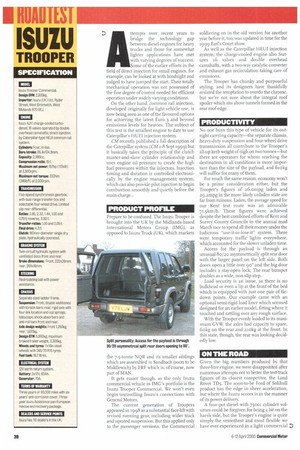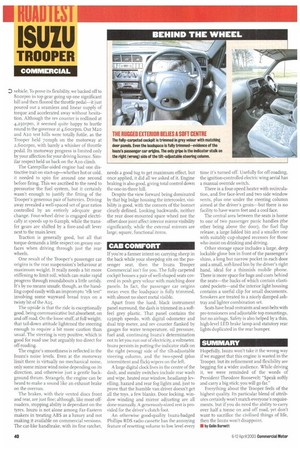ttem pts over recent years to bridge the technology gap
Page 40

Page 42

If you've noticed an error in this article please click here to report it so we can fix it.
between diesel engines for heavy trucks and those for somewhat lighter applications have met with varying degrees of success. Some of the earlier efforts in the field of direct injection for small engines, for example, can be looked at with hindsight and judged to have jumped the start. Their totally mechanical operation was not possessed of the fine degree of control needed for efficient operation under widely varying conditions.
On the other hand, common rail injection, developed originally for light vehicle use, is now being seen as one of the favoured options for achieving the latest Euro 3 and beyond emissions levels for heavies. The subject of this test is the smallest engine to date to use Caterpillar's H UE1 injection system.
CM recently published a full description of the Caterpillar system (CM 2-8 Sept 1999) but it basically takes the principle of the clutch master-and-slave cylinder relationship and uses engine oil pressure to create the high fuel pressures within the injectors. Injection timing and duration is controlled electronically by the engine management system, which can also provide pilot injection to begin combustion smoothly and quietly before the main charge..
PRODUCT PROFILE Prepare to be confused. The Isuzu Trooper is brought into the UK by the Midlands-based International Motors Group (1MG), as opposed to Isuzu Truck (UK), which markets
the 7.5-tonne NQR and its smaller siblings which are assembled in Sandbach (soon to be Middlewich) by FRF which is, of course, now part of MAN.
It gets easier though, as the only Isuzu commercial vehicle in IMG's portfolio is the Isuzu Trooper Commercial. We won't even begin unravelling Isuzu's connections with General Motors.
The current generation of Troopers appeared in 1998 as a substantial face-lift with revised running gear, including wider track and uprated suspension. But this applied only to the passenger versions, the Commercial
soldiering on in the old version for another year before it, too, was updated in time for the 1999 Earl's Court show.
As well as the Caterpillar HEU1 injection system, the charge-cooled engine also features 16 valves and double overhead camshafts, with a two-way catalytic converter and exhaust gas recirculation taking care of emissions.
The Trooper has chunky and purposeful styling, and its designers have thankfully resisted the temptation to overdo the chrome, but we're not sure about the integral roof spoiler which sits above tunnels formed in the rear roof-edge.
PRODUCTIVITY
No one buys this type of vehicle for its outright carrying capacity—the separate chassis, heavy-duty suspension and four-wheel drive transmission all contribute to the Trooper's all-up kerb weight of nigh on two tonnes—but there are operators for whom reaching the destination in all conditions is more important than the size of the payload, arid Giokg will suffice for many of them.
For much the same reason, economy won't be a prime consideration either, but the Trooper's figures of 26.0mpg laden and 29.2mpg in the more likely unladen state are far from ruinous. Laden, the average speed for our Kent test route was an admirable 7I.5km/h. These figures were achieved despite the best combined efforts of Kent and Surrey County Councils in the annual mad March race to spend all their money under the ludicrous "use-it-or-lose-it" system. There were temporary traffic lights everywhere, which accounted for the slower unladen time
Access for the payload is through an unusual 8o/zo asymmetrically split rear door with the larger panel on the left side. Both doors open a little over 90° and the big door includes a stay-open lock. The rear bumper doubles as a wide, non-slip step.
Load security is an issue, as there is no bulkhead or even a lip at the front of the bed which is equipped with just one pair of tiedown points. Our example came with an optional semi-rigid load liner which seemed designed for an earlier model, fitting where it touched and rattling over any rough surface.
With the Trooper evenly loaded to its maximum GVW, the axles had capacity to spare, 6okg on the rear and 210kg at the front. In this state, though, the rear was looking decidedly low.
ON THE ROAD
Given the big numbers produced by that three-litre engine, we were disappointed after numerous attempts not to better the test.track figures of its closest competitor, the Land Rover TD5, The soon-to-be Ford of Solihull product has the edge in sheer acceleration, but where the Isuzu scores is in the manner of its power delivery.
A four-pot diesel with 75occ cylinder volumes could be forgiven for being a bit on the harsh side, but the Trooper's engine is quite simply the smoothest and most flexible we have ever experienced in a light commercial
vehicle. To prove its flexibility, we backed off to 800rprn in top gear going up one significant hill and then floored the throttle pedal—it just poured out a seamless and linear supply of torque and accelerated away without hesitation. Although the rev counter is redlined at 4,250rpm, it seemed quite happy to hurtle round to the governor at 4, Goorpm, Our Mao and Azo test hills were totally futile, as the Trooper held vomph on the motorway at 2,600rpm, with barely a whisker of throttle pedal. Its motorway progress is limited only by your affection for your driving licence. Shnilar respect held us back on the A2 o climb.
The Caterpillar-aided engine had one distinctive trait on start-up—whether hot or cold, it needed to spin for around one second before firing. This we ascribed to the need to pressurise the fuel system, but it certainly wasn't enough to justify the fitting of the Trooper's generous pair of batteries. Driving away revealed a well-spaced set of gear ratios controlled by an entirely adequate gear change. Four-wheel drive is engaged electrically at speeds up to 62mph, while the transfer gears are shifted by a fore-and-aft lever next to the main lever.
Traction is generally good, but all that torque demands a little respect on greasy surfaces when driving through just the rear wheels.
One result of the Trooper's passenger car origins is the rear suspension's behaviour at maximum weight. It really needs a bit more stiffening to limit roll, which can make rapid progress through roundabouts a little untidy It's by no means unsafe, though, as the handling coped easily with an impromptu "elk test" involving some wayward bread trays on a twisty bit of the A25.
The upside is that the ride is exceptionally good, being communicative but absorbent, on and off road. On the loose stuff, at full weight, that tail-down attitude lightened the steering enough to require a bit more caution than usual. The steering is very positive, which is good for road use but arguably too direct for off-roading.
The engine's smoothness is reflected in the Isuzu's noise levels. Even at the motorway limit there is virtually no mechanical noise, only some minor wind noise depending on its direction, and otherwise just a gentle background thrum. Strangely, the engine can be heard to make a sound like an exhaust brake on the overrun.
The brakes, with their vented discs front and rear, are just fine; although, like most offroaders, stopping ability is dependant on the tyres. ISUZU is not alone among Far-Eastern makers in treating ABS as a luxury and not making it available on commercial versions. The car-like handbrake, with its fine ratchet,
needs a good tug to get maximum effect, but once applied, it did all we asked of it. Engine braking is also good, giving total control down the one-in-three hill.
Despite the view forward being dominated by that big bulge housing the intercooler, visibility is good, with the corners of the bonnet clearly defined. Looking backwards, neither the rear door-mounted spare wheel nor the offset door joint affect interior mirror visibility significantly, while the external mirrors are large, square, functional items.
CAB COMFORT
If you're a farmer intent on carrying sheep in the back while your sheepdog sits on the passenger seat, then the Isuzu Trooper Commercial isn't for you. The fully carpeted cockpit houses a pair of well-shaped seats covered in posh grey velour with matching door panels. In fact, the passenger car origins mean even the loadspace is fully trimmed, with almost no sheet metal visible.
Apart from the hard, black instrument panel surround, the dash is trimmed in a softfeel grey plastic. That panel contains the 125mph speedo, with digital odometer and dual trip meter, and rev counter flanked by gauges for water temperature, oil pressure, fuel and, continuing lsuzu's determination not to let you run out of electricity, a voltmeter. Isuzu persists in putting the indicator stalk on the right (wrong) side of the tilt-adjustable steering column, and the two-speed (plus intermittent and flick) wipers on the left.
A large digital clock lives in the centre of the dash, and sundry switches include rear wash and wipe, heated rear window, headlamp levelling, hazard and rear fog lights and, just to prove that the humble van driver doesn't get all the toys, a few blanks. Door locking, window winding and mirror adjusting are all done manually. A generously-sized rest is provided for the driver's clutch foot.
An otherwise good-quality Isuzu-badged Phillips R DS radio cassette has the annoying feature of resetting volume to low level every
time it's turned off. Usefully for off-roading, the ignition-controlled electric wing aerial has a manual override switch.
There is a four-speed heater with recirculafi on, and five face-level and two side window vents, plus one under the steering column aimed at the driver's groin but there is no facility to have warm feet and a cool face.
The central area between the seats is home to one of two passenger panic handles (the other being above the door), the fuel flap release, a large lidded bin and a smaller one with suitably cup-shaped recesses for those who insist on drinking and driving.
Other storage space includes a large, deep lockable glove box in front of the passenger's shins, a long but narrow pocket in each door and a small, soft-lined bin by the driver's right hand, ideal for a thinnish mobile phone. There is more space for bags and coats behind the seats—the backs of which contain elasticated pockets—and the interior light housing contains a useful clip for small documents. Smokers are treated to a nicely damped ashtray and lighter combination set.
Seats have head restraints and seat-belts with pre-tensioners and adjustable top mountings, but no airbags. Safety is also helped by a thin, high-level LED brake lamp and statutory rear lights duplicated in the rear bumper.
SUMMARY
Hopefully, Isuzu won't take it the wrong way if we suggest that this engine is wasted in the Trooper, but its refinement and flexibility are begging for a wider audience. While driving it, we were reminded of the words of President Theodore Roosevelt: "Speak softly and carry a big stick; you will go far."
Everything about the Trooper feels of the highest quality. Its particular blend of attributes certainly won't match everyone's requirements, but if you do need the ability to carry over half a tonne on and off road, yet don't want to sacrifice the civilised things of life, then the Isuzu won't disappoint.
• by Colin Barnett




















































































































